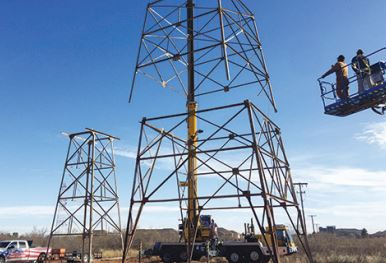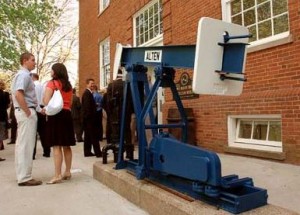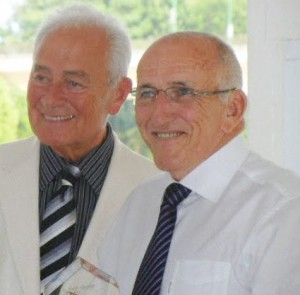A look back at some petroleum museum news, exhibits, and
community events.
To add your museum, update current information, or promote a news item, event, or exhibit opening, email bawells@aoghs.org with details. Also see News and Events page.
“Sweetest Festival in Texas” in 2020
The 32nd Heritage Syrup Festival will take place all day on November 14, 2020, at the Depot Museum and its grounds (five scenic acres, 12 historic and restored structures). Activities include bands and dancing at Heritage Square, Main Street, and the Civic Theatre in downtown Henderson. Organizers proudly claim the event among the “Sweetest Festival in Texas.” The Rusk County museum, a 1901 Missouri Pacific railway depot, “today is your ticket to East Texas heritage – and offers education instruction for folk arts.
East Texas Oil Museum at Kilgore College
Big Inch Pipeline Event – On January 25, 2020, a popular community oil museum and the Gregg County Historical Museum presented a special event, “Oil for Victory: Big Inch Pipeline Lecture and Panel” to celebrating the historic pipeline and the city of Longview’s sesquicentennial anniversary.
According to the East Texas Oil Museum, local historian Larry Courington explained the key role the Big Inch line played in fueling the Allies’ victory in World War II. The 1,254 mile-long pipeline transported Texas oil to the east coast. A panel discussion followed. Speakers included Don Carleton, executive director, Dolph Briscoe Center for American History at The University of Texas; Kimberly Fish, local author; Mickey Smith, former Gregg County Judge; and Luke Legate, director of G. Fox Consulting.
Boomtown Theater Renovation – In addition to the East Texas Oil Museum’s WWII pipeline exhibit, the museum’s popular Boomtown Theater reopened after a renovation, according to Manager Olivia Moore. It was the first significant renovation of the theater since the museum opened in 1980. A ribbon-cutting ceremony on February 1, 2020, included Moore, U.S. Rep. Louie Gohmert (R-TX), Kilgore College President Brenda Kays, and Kilgore Mayor Ronnie Spradlin.
“Thousands of visitors over the years have learned about the rich history of the East Texas Oil Boom, a history that took place right here in our backyard by watching ‘The Great East Texas Oil Boom’, a movie in the theater,” Kays noted. “Now, that movie has been digitized and it will last from this point forward into a state-of-the-art production and the theater has received major upgrades and renovations to improve the experience of our guests to the museum.”
According to the Kilgore News Hearld, “Kays acknowledged and thanked the city of Kilgore for their financial support of $140,000 towards the renovation project and announced Moore would hang a commemorative plaque in Boomtown Theater memorializing the date of the reopening.”
The East Texas Oil Museum at Kilgore College also hosts a variety of group events, including a meeting of the local chapter of the American Chemical Society. For more information, contact ETOM Manager Olivia Moore at (903) 983-8295 or email omoore@kilgore.edu.
Petroleum Museum in Midland, Texas, adds 1920s era Steel Derrick
A giant steel derrick has become the latest impressive outdoor attraction at the Petroleum Museum in Midland, Texas. “The Museum is erecting its newest Oil Patch exhibit – a late 1920s Emsco metal derrick used in the Darst Creek Oilfield in eastern Guadalupe County,” noted the museum’s quarterly newsletter Bits & Bytes in October 2019. “Hundreds of these derricks, often only 350 to 400 feet apart, dotted the oilfields around Luling.”

Discovered on July 18, 1929, by the Texas Comany, the oilfield would yield almost 107 million barrels of oil over the next three decades.
“These simple steel derricks play a huge part in the history of the petroleum industry,” noted a NewsWest9 reporter on November 18, 2019, adding, “Through the ’30s, steel derricks were used to drill oil wells but after their job was done they were left standing dormant throughout the United States.”
The Petroleum Museum’s facilities coordinator, James White, reportedly spend five years searching for a suitable historic steel derrick before finding one stacked in a field in Luling, Texas (home of another popular oil museum). Occidental Petroleum Corporation bought and donated the derrick to the Petroleum Museum; other Midland area companies donated other equipment.
Honoring America’s Petroleum Pioneers

Their reputations among peers speak of many noble achievements — and award deserving careers in the oil patch. Every year a select group oil and natural gas business leaders are honored by their colleagues, their industry, and their communities.
Among the most prestigious awards (to name only a few that take place every year) are: the Independent Petroleum Association of America, Washington, D.C., presentation of the Chief Roughneck Award at its annual meeting. The bronze “Joe Roughneck” statue has been presented since 1955. See “Meet Joe Roughneck.”
Other awards are presented by the Petroleum Museum in Midland, Texas, the Offshore Energy Center in Houston, Kansas museums in El Dorado and Great Bend, and the Pioneer Oil Museum in Bolivar, New York. All host special award events or maintain their own halls of fame honoring men and women of the petroleum industry.
Still other organizations, including professional trade groups like the Texas Alliance of Energy Producers, Wichita Falls, frequently host legends or legacy award dinners and luncheons. Universities in oil producing states also honor their alumni.
Ohio’s Marietta College, with its world-renowned geology and petroleum engineering program, adds members to its Petroleum and Geology Hall of Fame. The Ohio Oil & Gas Association maintains its hall of fame “as a way to honor those who have made their own distinct contributions to the Ohio oil and gas industry.”
Petroleum Museum Hall of Fame

The Petroleum Hall of Fame at the Petroleum Museum in Midland, Texas — which added five distinguished members on April 14, 2011, is “dedicated to those who cherished the freedom to dare, and whose work and service helped build the Permian Basin — Let their achievements be remembered and their beliefs inspire!”
The Hall of Fame received its first member in 1968, several years before the museum itself actually opened in 1975. Induction of the 100th member came in 1999. In each odd-numbered year a maximum of four people are inducted into the Hall of Fame.
Those inducted have been elected by the museum’s governing board, after an exhaustive study of their qualifications by a special committee. Candidates not chosen in the year submitted will be automatically reconsidered in future elections.
The 2011 inductees were I. Jon Brumley, Sam G. Gibbs, William D. Kleine, and “the team of Mack C. Chase and John R. Gray,” according to museum Director Kathy Shannon. Biographical files and portraits of each honoree are available in the museum archives.
Located in the heart of the Permian Basin in West Texas, The Petroleum Museum includes a 40,000-square-foot facility housing photographic wall murals depicting early life in the oilfields, a West Texas boomtown, and a marine diorama of 230 million years ago.
Colonel Edwin L. Drake Legendary Oilman Award

In late June, the Petroleum History Institute(PHI) of Oil City, Pennsylvania, presented a life-time achievement award during its History Symposium in Marietta, Ohio. Oilman I.L. “Ike” Morris received the Petroleum History Institute’s “highest honor and most prestigious award,” the Colonel Edwin L. Drake Legendary Oilman Award.
The June 23, 2011, presentation took place during the Institute’s annual symposium and field trip — as members cruised aboard a sternwheeler riverboat on the Ohio River following a reception and banquet. Larry D. Woodfork, PHI chairman of the honors and awards committee, presented this year’s award to Morris, founder and CEO of Waco Oil and Gas Company, Glenville, West Virginia.
Originally from Oklahoma, Morris established an oil service company in Gilmer County, West Virginia, in the early 1960s and eventually expanded into all exploration and production, notes an article in the Gilmer Free Press.

The PHI 2011 award was presented by Woodfork, an independent consulting geologist and emeritus state geologist of West Virginia. He praised Morris and his “stellar business career, great successes and accomplishments in the oil and gas industry, as well as his contributions to the local community, including the very generous philanthropy of he and his wife, Sue — a Gilmer County girl and long-time school teacher — to Glenville State College, their support of W.V.U., and numerous other charitable organizations and enterprises — the list of which goes on and on.”
Both Woodfork and Morris have been previously honored as the “West Virginia Oil and Gas Man of the Year” — Woodfork in 1991 and Morris in 1994. The award is made during the September annual West Virginia Oil and Gas Festivalheld in Sistersville, an historic oil community on the Ohio River.
Chronicle of Gulf of Mexico Petroleum History

Is knowledge of U.S. offshore exploration and production history important?
Although America’s offshore petroleum industry began in the Pacific Ocean more than 100 years ago, it wasn’t until 1947 that a company drilled beyond the sight of land — southwest of Morgan City, Louisiana.
Now available online: the first six volumes of a project to study Louisiana offshore petroleum history — a decade in the making and still in progress.
“Understanding Louisiana’s relationship with offshore energy development must begin in the bayous, lakes and marshes of south Louisiana in the late 1920s,” notes the Bureau of Ocean Energy Management, Regulation and Enforcement (BOEMRE), which is working with three universities to compile a history of southern Louisiana’s oil and natural gas industry.
Funded by the agency’s environmental studies program, the Offshore Oil and Gas History Project draws from economic research, oral histories, photographs, artifacts — and personal accounts gathered from former industry engineers, managers, workers, and community and political leaders, according to Ocean Science, a quarterly publication of BOEMRE, formerly the Minerals Management Service.
This offshore history project, begun in 2002 as a cooperative agreement with the Louisiana State University — which partnered with the University of Arizona and the University of Houston — has two phases. The six volumes of the completed first phase (a southern Louisiana offshore history up to 1970) are available online at the University of Arizona. The second phase focuses on the development farther offshore.
The first-quarter 2011 issue of BOEMRE’s Ocean Science notes that the two phases of the Offshore Oil and Gas History Project “forms the basis for understanding the evolution of the industry and how that is intertwined with local communities.”
Editor’s Note — The first U.S. well out of sight of land was drilled in 1947 in the Gulf of Mexico by Kerr-McGee Oil Industries partnered with Phillips Petroleum and Stanolind Oil & Gas companies. A freestanding platform was erected 10 miles offshore…in 18 feet of water. Read more at “Offshore Oil History.”
The American Oil & Gas Historical Society preserves U.S. petroleum history. Join AOGHS today to help maintain this energy education website, expand historical research, and extend public outreach. For annual sponsorship information, contact bawells@aoghs.org. © 2024 Bruce A. Wells.


